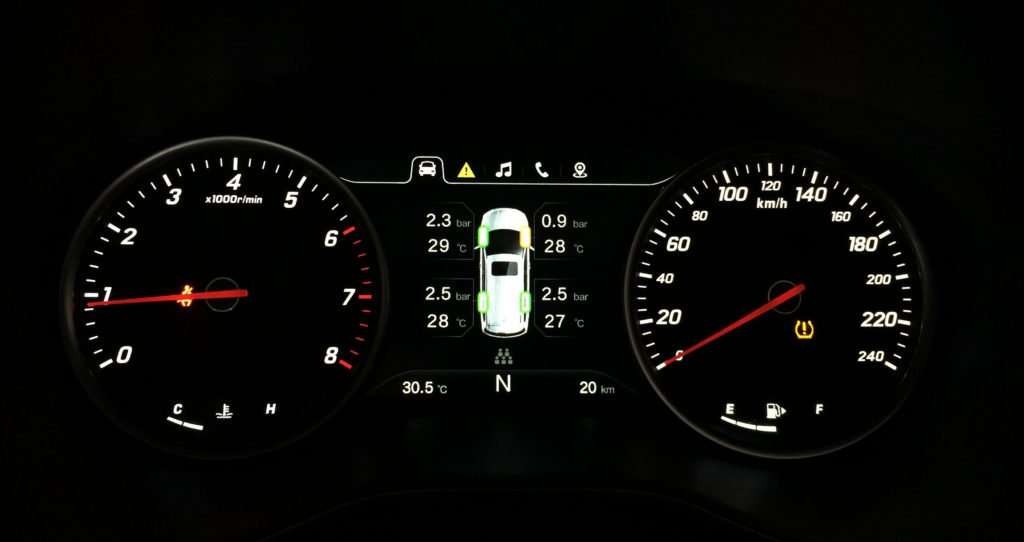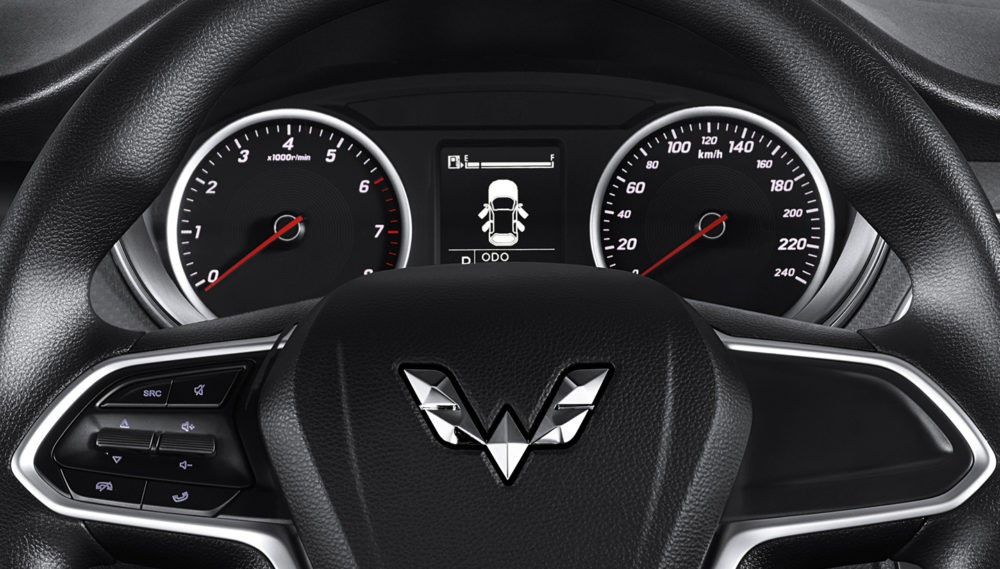The odometer in car is an essential instrument that displays the total distance your vehicle has traveled, providing valuable insights into its usage and maintenance needs, alongside mileage trackers. At CARS.EDU.VN, we help you understand the intricacies of your car’s systems, ensuring you stay informed about crucial components like the odometer, trip meter, and dashboard display. Discover more about vehicle history, mileage recording, and automotive technology with us.
1. Understanding the Car Odometer: An In-Depth Look
The odometer is more than just a gauge on your dashboard; it’s a critical tool that helps you understand your car’s history, plan maintenance, and even assess its value. Let’s dive into what an odometer is, its significance, and how it benefits you as a car owner.
1.1. Defining the Odometer: More Than Just a Number
An odometer is an instrument used to measure and display the total distance a vehicle has traveled since it was manufactured. Unlike the speedometer, which shows your current speed, the odometer provides a cumulative record of your car’s journey. This reading is crucial for several reasons, including tracking maintenance intervals, assessing a used car’s value, and monitoring fuel efficiency.
The odometer typically displays the distance in miles (in the United States and the United Kingdom) or kilometers (in most other countries). It’s usually located on the instrument cluster, easily visible to the driver.
1.2. The Importance of an Accurate Odometer
Having an accurate odometer is essential for several reasons:
- Maintenance Scheduling: Regular maintenance, such as oil changes, tire rotations, and brake inspections, is often based on mileage intervals. An accurate odometer ensures that you perform these tasks at the right time, keeping your vehicle in top condition.
- Warranty Validation: Many car warranties are based on both time and mileage. If your odometer isn’t accurate, it could affect your warranty coverage.
- Resale Value: The odometer reading is a significant factor in determining the value of a used car. Lower mileage generally translates to higher resale value, assuming the car has been well-maintained.
- Fuel Efficiency Tracking: By tracking your mileage and fuel consumption, you can calculate your car’s fuel efficiency. This helps you identify potential issues and save money on gas.
1.3. Odometer vs. Trip Meter: Knowing the Difference
While the odometer tracks the total distance traveled, the trip meter measures the distance of a specific journey. The trip meter can be reset to zero at the start of each trip, allowing you to track how far you’ve driven on a particular outing.
Here’s a comparison table to highlight the key differences:
| Feature | Odometer | Trip Meter |
|---|---|---|
| Purpose | Tracks total distance traveled by the vehicle | Tracks distance of a specific trip |
| Resetting | Cannot be reset (except in cases of repair) | Can be reset to zero at any time |
| Use Cases | Maintenance, resale value, warranty | Trip planning, fuel efficiency monitoring |
| Display | Continuous, cumulative reading | Resettable, short-term reading |



2. The Evolution of the Odometer: From Mechanical to Digital
The odometer has come a long way since its invention. Initially, odometers were purely mechanical devices, but modern cars now use electronic odometers that offer greater accuracy and features. Let’s explore the fascinating evolution of this essential instrument.
2.1. The Mechanical Odometer: A Relic of the Past
The earliest odometers were mechanical devices that used a series of gears and cables to record distance. These odometers were directly connected to the vehicle’s wheels, and as the wheels turned, the gears would rotate, incrementing the mileage count.
Mechanical odometers were simple and reliable, but they had limitations:
- Accuracy: Mechanical odometers could be less accurate due to wear and tear on the gears and cables.
- Tampering: It was relatively easy to tamper with mechanical odometers, rolling back the mileage to increase a car’s resale value.
- Features: They offered limited functionality, typically displaying only the total mileage.
2.2. The Electronic Odometer: A Modern Marvel
Electronic odometers use sensors and computer technology to measure and display distance. These odometers are more accurate and offer advanced features compared to their mechanical counterparts.
Here are some advantages of electronic odometers:
- Accuracy: Electronic odometers are highly accurate, using precise sensors to measure wheel rotation.
- Security: They are more difficult to tamper with, as the mileage data is stored in the car’s computer system.
- Features: Electronic odometers can offer additional features, such as trip meters, fuel efficiency calculations, and diagnostic information.
- Integration: They can be integrated with other vehicle systems, such as the navigation system and the car’s computer.
2.3. How Electronic Odometers Work: A Technical Overview
Electronic odometers typically work by using a wheel speed sensor to measure the rotation of the vehicle’s wheels. The sensor sends a signal to the car’s computer, which calculates the distance traveled based on the wheel’s circumference. The computer then updates the odometer display accordingly.
The process can be summarized as follows:
- Wheel Speed Sensor: A sensor detects the rotation of the wheels.
- Signal Transmission: The sensor sends a signal to the car’s computer.
- Distance Calculation: The computer calculates the distance traveled based on the wheel’s rotation.
- Odometer Update: The odometer display is updated with the new mileage reading.
3. Decoding the Numbers: Understanding Odometer Readings
The odometer reading is a crucial piece of information about your car’s history and condition. Knowing how to interpret these numbers can help you make informed decisions about maintenance, repairs, and buying or selling a used car.
3.1. What the Numbers Tell You: Interpreting Mileage
The odometer reading indicates the total distance your car has traveled in its lifetime. Higher mileage generally means more wear and tear on the vehicle, while lower mileage may suggest that the car has been used less frequently.
Here’s a general guideline for interpreting mileage:
- Low Mileage (Under 75,000 miles): Indicates relatively low usage and potentially less wear and tear.
- Average Mileage (75,000 – 150,000 miles): Suggests typical usage for a car that is several years old.
- High Mileage (Over 150,000 miles): Indicates significant usage and potentially more wear and tear.
However, mileage is just one factor to consider. A car with high mileage that has been well-maintained may be in better condition than a car with low mileage that has been neglected.
3.2. Mileage and Maintenance: Planning for the Future
The odometer reading is your guide to scheduling routine maintenance. Most car manufacturers provide recommended maintenance schedules based on mileage intervals.
Here are some common maintenance tasks and their typical mileage intervals:
| Maintenance Task | Mileage Interval |
|---|---|
| Oil Change | 5,000 – 7,500 miles |
| Tire Rotation | 6,000 – 8,000 miles |
| Brake Inspection | 15,000 – 20,000 miles |
| Spark Plug Replacement | 30,000 – 50,000 miles |
| Coolant Flush | 30,000 – 60,000 miles |
By following these maintenance schedules, you can keep your car running smoothly and prevent costly repairs down the road.
3.3. Odometer Discrepancies: Red Flags to Watch Out For
Odometer fraud is a serious issue that can cost unsuspecting buyers thousands of dollars. It involves tampering with the odometer to make a car appear to have lower mileage than it actually does.
Here are some red flags to watch out for when buying a used car:
- Inconsistent Wear and Tear: Check for inconsistencies between the odometer reading and the car’s overall condition. For example, if the odometer shows low mileage but the seats are worn and the pedals are heavily used, it could be a sign of odometer fraud.
- Missing or Tampered Stickers: Look for stickers on the doorjamb or under the hood that indicate when the car was last serviced. If these stickers are missing or appear to have been tampered with, it could be a red flag.
- Title Issues: Check the car’s title for any discrepancies in the mileage history. If the title indicates a higher mileage reading than what’s currently displayed on the odometer, it could be a sign of fraud.
- Unusual Gaps in Mileage History: Review the car’s maintenance records for any unusual gaps in the mileage history. For example, if the car suddenly jumps from 50,000 miles to 100,000 miles in a short period, it could be a sign of odometer tampering.
- Professional Inspection: Have a trusted mechanic inspect the car before you buy it. A mechanic can identify potential issues and help you determine if the odometer has been tampered with.
4. Common Odometer Problems and Solutions
While odometers are generally reliable, they can sometimes experience problems. Understanding these issues and how to address them can save you time and money.
4.1. Mechanical Odometer Issues: Troubleshooting Tips
Mechanical odometers can suffer from several common problems, including:
- Sticking Numbers: The numbers on the odometer may stick or become misaligned, making it difficult to read the mileage.
- Cable Breaks: The cable that connects the odometer to the wheels can break, causing the odometer to stop working.
- Gear Wear: The gears inside the odometer can wear down over time, leading to inaccurate readings.
Here are some troubleshooting tips for mechanical odometer issues:
- Check the Cable: Inspect the cable for any signs of damage or wear. If the cable is broken, it will need to be replaced.
- Lubricate the Gears: Apply a small amount of lubricant to the gears inside the odometer to help them move more freely.
- Seek Professional Help: If you’re not comfortable working on the odometer yourself, take the car to a qualified mechanic.
4.2. Electronic Odometer Issues: Diagnosis and Repair
Electronic odometers can also experience problems, although they are generally more reliable than mechanical odometers. Common issues include:
- Display Malfunctions: The odometer display may flicker, dim, or stop working altogether.
- Sensor Problems: The wheel speed sensor may fail, causing the odometer to stop recording mileage.
- Computer Issues: The car’s computer may malfunction, leading to inaccurate odometer readings.
Here are some tips for diagnosing and repairing electronic odometer issues:
- Check the Fuses: Inspect the car’s fuses to see if any are blown. Replace any blown fuses with new ones of the same rating.
- Test the Sensor: Use a multimeter to test the wheel speed sensor. If the sensor is not working properly, it will need to be replaced.
- Scan for Error Codes: Use an OBD-II scanner to check for any error codes related to the odometer or wheel speed sensor. These codes can help you diagnose the problem.
- Consult a Professional: If you’re not comfortable working on the car’s electrical system, take it to a qualified mechanic.
4.3. When to Seek Professional Help: Knowing Your Limits
While some odometer issues can be resolved with basic troubleshooting, others require professional expertise. If you’re not comfortable working on your car’s electrical or mechanical systems, it’s best to seek help from a qualified mechanic.
Here are some situations where you should consult a professional:
- Complex Repairs: If the odometer requires extensive repairs, such as replacing gears or sensors, it’s best to leave it to a professional.
- Electrical Issues: If the problem involves the car’s electrical system, it’s best to consult a mechanic with expertise in automotive electronics.
- Uncertain Diagnosis: If you’re not sure what’s causing the odometer problem, a professional can diagnose the issue and recommend the appropriate repairs.
5. Maintaining Odometer Accuracy: Tips and Best Practices
Keeping your odometer accurate is essential for tracking maintenance, assessing your car’s value, and ensuring warranty coverage. Here are some tips and best practices for maintaining odometer accuracy.
5.1. Regular Maintenance: Keeping Your Car in Top Shape
Regular maintenance is crucial for keeping all of your car’s systems in good working order, including the odometer. By following the manufacturer’s recommended maintenance schedule, you can prevent many common odometer problems.
Here are some maintenance tasks that can help maintain odometer accuracy:
- Tire Maintenance: Keep your tires properly inflated and rotated. This can help ensure that the wheel speed sensors are working accurately.
- Brake Maintenance: Inspect your brakes regularly and replace them as needed. Worn brakes can affect the wheel speed sensors and lead to inaccurate odometer readings.
- Wheel Alignment: Have your wheels aligned periodically. Misaligned wheels can cause uneven tire wear and affect the accuracy of the odometer.
5.2. Avoiding Odometer Tampering: Protecting Your Investment
Odometer tampering is a serious crime that can have significant financial consequences. To protect yourself from odometer fraud, follow these tips:
- Buy from Reputable Dealers: Purchase used cars from reputable dealers who have a track record of honesty and integrity.
- Inspect the Car Carefully: Examine the car for any signs of odometer tampering, such as inconsistent wear and tear or missing stickers.
- Check the Title: Review the car’s title for any discrepancies in the mileage history.
- Get a Vehicle History Report: Obtain a vehicle history report from a reputable provider, such as CARFAX or AutoCheck. These reports can reveal any instances of odometer fraud.
- Have the Car Inspected: Have a trusted mechanic inspect the car before you buy it. A mechanic can identify potential issues and help you determine if the odometer has been tampered with.
5.3. Documenting Mileage: Keeping Accurate Records
Keeping accurate records of your car’s mileage is essential for tracking maintenance, assessing its value, and resolving any potential odometer issues. Here are some tips for documenting mileage:
- Record Mileage at Each Service: Note the odometer reading each time you have your car serviced.
- Keep Maintenance Records: Save all of your car’s maintenance records, including receipts and invoices.
- Use a Mileage Tracking App: Consider using a mileage tracking app to record your car’s mileage automatically.
- Photograph the Odometer: Take a photo of the odometer each time you have your car serviced. This can provide visual proof of the mileage reading.
6. The Future of Odometers: Innovations and Advancements
The odometer is constantly evolving, with new technologies and features being introduced to improve accuracy, security, and functionality. Let’s take a look at some of the latest innovations in odometer technology.
6.1. Digital Odometers and Data Security
Modern digital odometers offer enhanced data security features to prevent tampering and fraud. These features include:
- Encrypted Data Storage: Mileage data is stored in the car’s computer using encryption, making it more difficult to alter.
- Tamper-Proof Seals: Tamper-proof seals are used to protect the odometer and prevent unauthorized access.
- Mileage Verification Systems: Some manufacturers are implementing mileage verification systems that use blockchain technology to ensure the accuracy of odometer readings.
These advancements are making it more difficult for criminals to commit odometer fraud and protecting consumers from financial losses.
6.2. Integration with Vehicle Telematics
Many new cars are equipped with telematics systems that can track and transmit mileage data to the cloud. This data can be used for a variety of purposes, including:
- Remote Odometer Readings: Car owners can access their car’s odometer reading remotely using a smartphone app or website.
- Automatic Maintenance Reminders: The car can automatically send maintenance reminders based on mileage intervals.
- Theft Recovery: The telematics system can help locate the car if it’s stolen.
- Insurance Discounts: Some insurance companies offer discounts to drivers who allow their mileage data to be tracked.
The integration of odometers with vehicle telematics is making car ownership more convenient and providing valuable insights into vehicle usage and maintenance needs.
6.3. The Role of AI in Odometer Technology
Artificial intelligence (AI) is playing an increasingly important role in odometer technology. AI algorithms can be used to:
- Detect Odometer Fraud: AI can analyze odometer data to identify patterns that suggest tampering or fraud.
- Predict Maintenance Needs: AI can predict when a car will need maintenance based on its mileage and driving habits.
- Optimize Fuel Efficiency: AI can analyze mileage and fuel consumption data to optimize fuel efficiency.
As AI technology continues to evolve, it will likely play an even greater role in the future of odometers.
7. CARS.EDU.VN: Your Trusted Source for Automotive Information
At CARS.EDU.VN, we understand the importance of having accurate and reliable information about your car. Whether you’re looking for maintenance tips, repair advice, or information about the latest automotive technologies, we’re here to help.
7.1. Comprehensive Guides and Resources
We offer a wide range of comprehensive guides and resources to help you understand every aspect of your car, including the odometer. Our articles are written by experienced automotive experts and are designed to be easy to understand, even if you’re not a mechanic.
Here are some of the topics we cover:
- Odometer Basics: Learn about the history, function, and types of odometers.
- Maintenance Tips: Get expert advice on how to maintain your car and keep it running smoothly.
- Repair Guides: Find step-by-step instructions for repairing common car problems.
- Buying and Selling: Get tips on how to buy or sell a used car, including how to avoid odometer fraud.
- New Technologies: Stay up-to-date on the latest automotive technologies, including AI and telematics.
7.2. Expert Advice and Support
Our team of automotive experts is available to answer your questions and provide personalized advice. Whether you’re dealing with an odometer problem or just need help understanding your car’s features, we’re here to assist you.
You can reach us through our website, email, or phone. We’re committed to providing you with the best possible service and helping you get the most out of your car.
7.3. Connecting You with Trusted Service Providers
Finding a trustworthy mechanic or service provider can be a challenge. That’s why we partner with reputable businesses in your area to provide you with quality service and support.
Whether you need an oil change, brake repair, or odometer inspection, we can connect you with a trusted service provider who will treat you fairly and provide you with the best possible care.
8. Conclusion: The Odometer – A Small Device with a Big Impact
The odometer is a small but essential device that plays a crucial role in your car’s operation and maintenance. Understanding how it works, how to interpret the readings, and how to maintain its accuracy can save you time, money, and headaches.
At CARS.EDU.VN, we’re committed to providing you with the information and resources you need to be a knowledgeable and responsible car owner. Whether you’re a seasoned mechanic or a first-time car buyer, we’re here to help you navigate the complex world of automotive technology.
Remember, regular maintenance, careful record-keeping, and a healthy dose of skepticism when buying used cars can go a long way in protecting your investment and ensuring your safety on the road.
Need help finding reliable service or understanding your car better? Visit CARS.EDU.VN today for expert advice and connections to trusted service providers.
Address: 456 Auto Drive, Anytown, CA 90210, United States
Whatsapp: +1 555-123-4567
Website: cars.edu.vn
9. FAQs About Car Odometers
Here are some frequently asked questions about car odometers:
9.1. What is the average mileage for a car?
The average mileage for a car is typically around 12,000 to 15,000 miles per year. However, this can vary depending on factors such as driving habits, location, and vehicle type.
9.2. How do I reset my trip meter?
Most cars have a button or knob on the instrument cluster that allows you to reset the trip meter to zero. Refer to your owner’s manual for specific instructions.
9.3. Can I replace my odometer?
Yes, you can replace your odometer if it’s damaged or malfunctioning. However, it’s important to follow all applicable laws and regulations regarding odometer replacement.
9.4. What is odometer rollback?
Odometer rollback is the illegal practice of tampering with the odometer to make a car appear to have lower mileage than it actually does.
9.5. How can I check for odometer fraud?
You can check for odometer fraud by inspecting the car carefully, checking the title, obtaining a vehicle history report, and having the car inspected by a trusted mechanic.
9.6. What should I do if I suspect odometer fraud?
If you suspect odometer fraud, report it to the National Highway Traffic Safety Administration (NHTSA) and consult with an attorney.
9.7. Is it legal to replace my odometer with a used one?
Laws vary by state, but generally, it is legal to replace your odometer with a used one as long as you disclose the replacement to the buyer when you sell the car.
9.8. How accurate are digital odometers?
Digital odometers are generally very accurate, typically within a few percentage points of the actual mileage.
9.9. Can a car run without an odometer?
Yes, a car can run without a functioning odometer, but it’s important to repair or replace the odometer as soon as possible to avoid potential problems with maintenance, warranty, and resale value.
9.10. Does the odometer affect my insurance rates?
Yes, the odometer reading can affect your insurance rates. Lower mileage may result in lower insurance rates, as it suggests that the car is driven less frequently.
